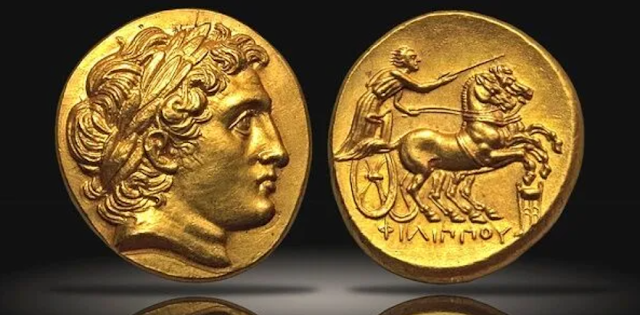With no mass media, ancient coins functioned as powerful tools for propaganda due to their portability and potential to circulate widely. Rulers would carefully choose their types and each element of the designs of their coinage to convey a specific message to their subjects, allies, and enemies.
Alexander the Great understood this concept and carefully planned the specific details of his portraits on sculptures as well as coins. Alexander is represented most famously as Herakles on his tetradrachms. He aspired to be a hero himself and Herakles was the premier embodiment of strength, determination, and willpower in Greek Religion, traits central to Alexander’s mission of global dominance.
After Alexander died suddenly at the age of 32, the future of his vast empire was unknown. His generals scrambled to determine who should succeed him as Alexander had no heir.
On his deathbed, Alexander passed his signet ring to Perdiccas, the leader of his elite calvary, nominating him as his successor, but Perdiccas did not claim power immediately. Princess Roxana of Bactria was pregnant with Alexander’s child at the time of his death, and the gender of the baby was unknown.
Perdiccas argued that they should wait to see if the unborn child would be male and therefore have a legitimate claim to the throne. The infantry instead proposed that Philip III Arrhidaios, Alexander’s half-brother, should rule regardless of the gender of Roxana’s baby.
The factions reached a compromise, and when Alexander IV was born in August 323 BCE, he and Philip III were jointly made kings but acted only as figureheads, while Perdiccas would actually rule the Empire as regent.
This coin was minted within a year of Alexander’s death, and it retained the type started by Philip II of a portrait on the obverse and a charioteer driving galloping horses on the reverse. However, its style marked a significant deviation from any of the other gold staters of the era.
The type was struck in both Kolophon and Magnesia from a single obverse die which was transported and used in the two mints, indicating that it was clearly a critically important design that could not be easily replicated by a different artist due to its intricacy.
Most of the Macedonian staters depict the God Apollo, but this coin features Alexander himself, representing one of his earliest surviving portraits. It was engraved by an uncommonly talented artist, sculptural in nature, reflecting identical facial features to known depictions of Alexander in its magnificent, gem-like composition.
Alexander’s portrait was likely placed on the obverse in an attempt to legitimize the new haphazard regime, associating the image of the well-known ruler to denote his blessing. By replacing the God Apollo, the “Bringer of Light”, with the portrait of Alexander, the coin also conveys the message that Alexander carried the light and wisdom of Hellenistic society throughout the known world.
The coin’s beauty and historical importance have made it one of the most desirable and exciting of all gold staters minted in the name of Philip.
Despite the effort put into the development of this coin and the extensive negotiations, the new regime was met with confusion and discomfort, eventually resulting in the assassination of Perdiccas in 321 BCE and 40 years of war between the fragmented powerful generals, splitting Alexander’s Empire into the Ptolemaic Kingdom, the Seleucid Empire, the Kingdom of Pergamon, and Macedonia.
Edited from coinweek














No comments:
Post a Comment